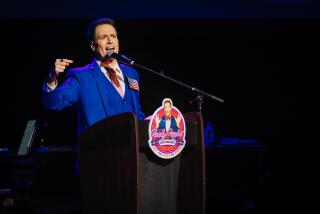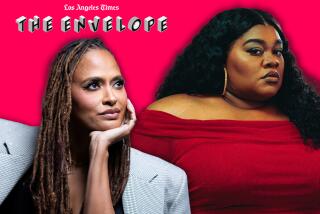MOVIE REVIEW : A Luminous Version of ‘Rainbow’
- Share via
. . . There was a faint vast rainbow . . . its pedestals luminous in the corruption of new houses on the low hill, its arch the top of heaven.
--D. H. Lawrence, “The Rainbow”
The rainbow that arches away from the muddy, mundane colliery town toward the vaults of heaven at the end of D. H. Lawrence’s great 1915 novel is, for his heroine Ursula Brangwen, a symbol of the exaltation that drives her on, makes her dissatisfied with town, family, friends and lovers.
But for Ken Russell, in his movie of “The Rainbow” (opening Friday at the Royal), this vision of sun and rain is slighter, sweeter. It’s a candy-colored little arc, bright as jam, that Ursula first sees in childhood. It lies over an enchanted rural dell that might be the gateway to Oz or Wonderland.
Perhaps those rainbows signal the difference between book and film. The novel gouges and bites, leaves bloody marks and the salt of tears in its havoc-strewn wake. The movie is emerald-green and pretty to a fault, a lovely little bauble that gleams in your hand like an ice crystal about to melt.
In Lawrence’s “Rainbow,” we see what happened to the Brangwen sisters, Ursula and Gudrun, before his later novel “Women in Love” began. It’s a long family saga in which Ursula’s revolt is fed by three generations of frustration and buried dreams; Russell’s movie only covers the last six of its 16 chapters.
Russell’s “Rainbow,” done with the sure-handed expertise of a born film maker, mostly details six years in the life of Ursula (Sammi Davis). The film takes her from virginity to her first great love, Anton Skrebensky (Paul McGann), through a rhapsodic lesbian interlude with her teacher Winifred (Amanda Donohoe), through the scalding experience of her first job, as elementary teacher in a school, bedeviled by a brutal headmaster (Jim Carter’s Harby) and snot-faced, sneering delinquents.
The movie’s Ursula, like Lawrence’s, is in rebellion against dead forms and stale proprieties. Passionate, selfish and anti-democratic, she’s determined to flee the repetitions and traps of her existence, to live clean, free and whole. For Lawrence, there’s a desperation to this flight, but Russell takes a lustier tone. His style doesn’t reflect Lawrence’s, but complements it. It’s warmer and wittier, more artificial and unnatural.
When Russell adapted “Women in Love” two decades ago, he was like a brawny magician with a hot poker for a wand. He knew how explosive the material was and he used Lawrence’s Edwardian sexual memoir-fable like a grenade, blasting the screen with passionate images. Yet he also played the material lyrically, lightly, turned it into a near-musical.
In Russell’s “Rainbow,” the lyricism predominates, fittingly since it’s a film about rural roots and a young girl’s coming-of age--but also, perhaps because, with a limited budget and the whole glacial process of movie-making these days, he has to play it safe. His movie celebrates Ursula’s rebellion, but it shows a reverence for the land and countryside that wasn’t as present in “Women.”
Much of the darkness has gone out of the story, the black rages of Ursula, her lovers and parents. It’s been transferred to more obvious villains: headmaster Harby, turned here into a Dickensian bully, and the Russell-created sadist-Sunday painter, McAllister (Dudley Sutton). Even Winifred, her role much expanded, is played with some of the demonic edge of her vampire-princess in Russell’s “Lair of the White Worm.”
Perhaps Russell, in his 60s, doesn’t feel as much like throwing grenades. For D. H. Lawrence, heaven and hell could both be encompassed in the lusts and loves of the body, but for Ken Russell, sexuality is just as often horrific or comic. Though he hasn’t stinted on the story’s sexual frankness or social abrasiveness, Russell has taken a softer, gentler tone, so much so that Sammi Davis’ Ursula, played with the physicality and raw force of the earlier film, often seems out of place, like a strident chalk squeak against the story’s glassy surface.
Russell deliberately brings back many of his “Women in Love” collaborators, giving the project an air of reverie and reunion: cinematographer Billy Williams, designer Luciana Arrighi. Glenda Jackson, who earlier played Gudrun, the icy aesthete, here appears as Gudrun’s mother, Anna. Once again, she gives the finest performance in the movie. And Christopher Gable, who, in “Women in Love,” played the young drowned aristocrat, is here the ever-grinning father Will Brangwen.
Because of all this--the nostalgia and sentiment--”The Rainbow” has been hailed by some as Russell’s return to form, his best film since “Women in Love.” I disagree, but only because I think Russell’s form never left him. Excellent as this movie is, his most exciting and creative cinematic work tends to be in his musical films and composer biographies, from the BBC’s “Song of Summer” onward.
He is often at his best when he seems most outrageous and unfettered. Yet in “The Rainbow,” he proves he can wear his fetters well. Just as Ursula’s rainbow shoots up to heaven from the dark, corrupted ground, Russell’s “Rainbow” (MPAA rated R for nudity, sex and language) carries the glint of passion, revolt, art: jewels of the spirit shining through the flood as it regenerates and renews the earth.
‘THE RAINBOW’
A Vestron pictures presentation. Producer/director/script Ken Russell. Co-script Vivian Russell. Executive producers William J. Quigley, Dan Ireland. Camera Billy Williams. Music Carl Davis. Editor Peter Davies. Production Design Luciana Arrighi. With Sammi Davis, Paul McGann, Amanda Donohoe, Christopher Gable, David Hemmings, Glenda Jackson, Dudley Sutton, Jim Carter.
More to Read
Only good movies
Get the Indie Focus newsletter, Mark Olsen's weekly guide to the world of cinema.
You may occasionally receive promotional content from the Los Angeles Times.










